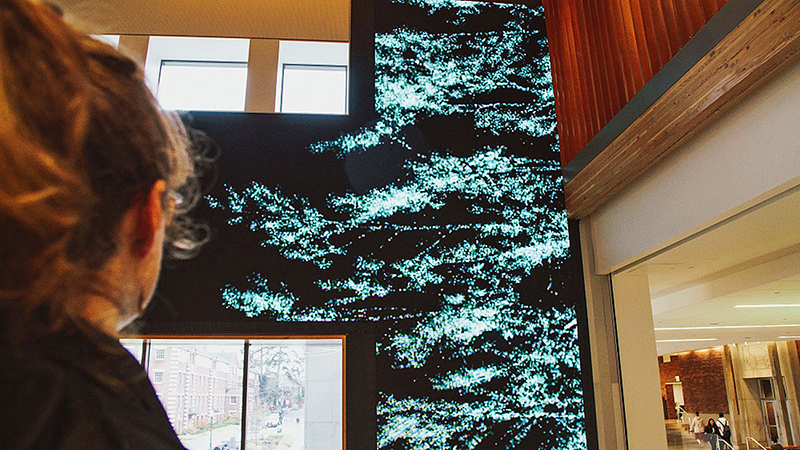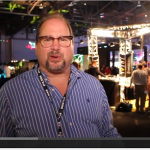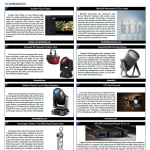
The Pacific Northwest part of America is well known for the beauty of their forested woodlands, especially the majestic Douglas Fir trees that have been known to rise 300’up into the sky. Lead Pencil Studio, an art and architectural firm out of Seattle chose to pay homage to these local giants when commissioned to erect “Sunrise, Sunset” a video mural of artwork that follows the life of a single tree from seedling to its full 500 year old maturity every 24 hours.
The entire cycle of life starts every morning at 7 a.m. in the recently renovated Erb Memorial Student Union building at the University of Oregon in Eugene. Over the course of the day a sapling grows out of the earth on a 50’ high T-shaped video structure that was installed in 2019, growing steadily over the course of the day until it reaches its peak at midnight, falling to the ground before starting anew again the following morning.
The idea for this art project stemmed from the minds of Annie Han and Daniel Mihalyo, partners at Lead Pencil Studio. Quoting Han, “The Douglas Fir is one of our great natural resources. We wanted to base our artwork around one of the great natural resources this area has to offer us. I wanted to make an artwork about that – how lucky we are to have this beautiful thing around us all the time.”
The project itself started growing in 2016 when Rebecca Banyas, manager of the Oregon Arts Commission’s Public Art Project put together the EMU artist selection committee, a group of many including professor of art Carla Bengston to put out a call for proposals. Oregon has a wonderful rule called the Oregon Arts Commissions Percent for Art program. This states that 1% of all funds dedicated to new or remodeled state buildings must go to art projects. Lead Pencil Studio’s concept was chosen because it was deemed innovative, captivating, and had a strong connection based with the local nature of Oregon. It may have helped that the two artists are alumni of the school.
The project was to be erected in the Student Union building as many people pass through this structure regularly and might catch a view of the tree at any stage during its life, dependent on the time of day. The shape of the LED display was paramount to the project as it would fit the tall, narrow space allotted for the installation. The video itself was chosen to be slow moving and grainy looking on purpose, as to not take away from the majestic soft wood trees on display behind the neighboring windows. “People come to the student union to take a break and read. The idea is that every time they look up the tree will have grown more.” claims Han.

An Idea Comes to Fruition
Once the artistic team‘s proposal was chosen, the next obstacle was finding the proper equipment and construction people to mount this permanent install in place. The art piece needed to retain its form when viewed from any angle and look seamless. Yes Tech and their MC Series was chosen after Lead Pencil Studio sourced Yes Tech, after comparing the quality of the systems available for direct purchase and attending a technical convention in Los Angeles. Because it was an indoor installation, low brightness was actually preferred.
Daniel Mihalyo of Lead Pencil Studio contacted and contracted directly with Yes Tech. After consulting with them he chose the MC Series with a pixel pitch of 5.2 for the job because they needed an indoor product that could be permanently attached to a wall and be serviced through the front. The designers did not want an extremely high definition product that would put a strain on one’s eyes over time and they purposely made the content grainy. The 5.2 pitch and ease of installation for this product made it a no brainer to go to Yes Tech for what they required.
Also noted by the team was the light weight and modular design, along with safe modular coupling for assembly. The display, receiver and driver are all integrated into the cabinet. The inside of the cabinet is literally wireless as the pin header used connects the driver boards directly to each cabinet. This IP 50 rated product boasts a better dust covering than others, making it ideal for protecting the internal electronics over their long life span on this permanent installation. By being front serviceable, the Yes Tech MC Series is incredibly modular, as a tile can be replaced in five seconds. If the tile itself needs to be serviced, the replacement of any power supply or receiver also takes about 30 seconds. In addition, the cabinet’s depth is under 2.5” and made with a material of high polymer nanotechnology, eliminating the heavy weight of a steel frame model. Each cabinet weighs just 10.6 lbs. Each cabinet contains four separate modules. Silent operation was also a factor as students did not need to be distracted by ambient noise.
Vivian Long, international sales engineer for Yes Tech was instrumental in providing the technical information needed for the owner to install. The general contractor, Lease Crutcher Lewis in Eugene (who worked on the $90 million addition and renovation project), performed the primary work with the artists of the technical installation of the screens and equipment.
Attaching the LED tiles to the wall required a few steps. Yes Tech sent a few sample tiles to Lead Pencil Studios so they could have the actual metal frames for the tiles fabricated locally, before handing them to the construction company for assembly.
To assemble this 12.5m x 11m video wall, Lease Crutcher Lewis ran 2×6 pieces of wood, fastening them horizontally to the existing wall’s structural metal studs behind the dry wall The crew then attached structural aluminum tubes that ran vertically every ½ meter to this wood, before fastening the frames and cabinets into place. The assembly only took two days due to the fast and easy installation process of the 246 tiles. Each tile is a 500 mm square with four modules in it. The modules are held in place on the frames with magnets, but there are screw holes available for an extra safety factor should clients be concerned. The entire structure including the wood and frames weighed only 3100 lbs. The precision coupling of the tiles was paramount with the shape of this structure as the art project demanded a seamless connection between every cabinet.

Completing the concept
The artists designed the video panels into an asymmetrical T-shape of sorts that allowed the screen array to cover existing wall space without blocking the windows. As the tree grew upward, it eventually spouts long sideways branches that occupy the left side of the LED display that extends over the window. Mihalyo adds “Our intent was for it to be a meditative and ambient piece. We hoped students could take a break from studying to zone-out and go into that deep mental space for a minute and then return to studies.”
Capturing the different stages of life the douglas fir goes through was time consuming. The pair made use of LiDAR, a 3D-scanning software used for measuring distances by sending pulsing laser light and measuring the reflection time with a sensor. Differences in return times and wavelengths can then be used to make digital 3-D representations of the target using millions of point measurements.
Lead Pencil Studio is no stranger to large-scale public art installations. In 2019 alone, the duo completed the 100-foot-tall “Transforest” sculpture in Seattle and the 30 foot tall “Oblique Intersection” at Texas Tech University. For this project at their alma mater, they spent three weeks researching in the mountains and forest of Oregon to capture the state’s largest old-growth trees using LiDAR. They then transferred this data into a sequence of digital models that progressed in size, creating an 18-hour animated video file for playback. Naturalistic effects were added to complete a time-lapse sequence depicting the life of a single douglas fir tree from seedling to ancestor tree. Such things such as passing mist, sunrise, snowstorms, rain and birds were introduced at brief interludes to accompany the tree’s 500 year journey. At midnight the tree falls, becoming a nurse log, from which the sapling grows out of to start the process all over again.
One of the initial thoughts the artists had was that students could sync their schedules to the artwork. Perhaps meeting when the snowstorm hits or taking a reminder that it’s time to head home when the tree falls. After all, when the tree falls to the forest floor, the lights in the building begin to dim for the evening to signal it’s time to stop studying and head home to rest ourselves.


